
Port Glasgow railway station is on the Inverclyde Line, serving the town of Port Glasgow, Scotland. It is located in the town centre with the main entrance at the junction of Princes Street and John Wood Street.

Paisley St James railway station is on the Inverclyde Line, serving one of the residential districts of the town, just west of the town centre. For passengers travelling to the commercial district, Paisley Gilmour Street is the main railway station of Paisley and is located in the heart of Paisley town centre. There is an ongoing campaign to rename the station "Paisley St Mirren" due to the station's proximity to St Mirren's new stadium.
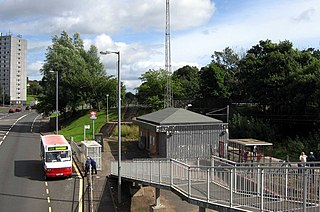
Branchton railway station is a railway station in Scotland opened in 1967 under British Rail located in the south-west of the town of Greenock, beside the area called Branchton. The station is on the Inverclyde Line, 24¾ miles (40 km) west of Glasgow Central. The station is managed by ScotRail.

Livingston South railway station is one of two railway stations serving Livingston in West Lothian, Scotland. It is located on the Shotts Line, 14 miles (23 km) west of Edinburgh Waverley on the way to Glasgow Central. It is managed by ScotRail, who provide all train services.

Pollokshaws West railway station is a railway station in Glasgow, Scotland. The station is managed by ScotRail and is served by trains on the Glasgow South Western Line.
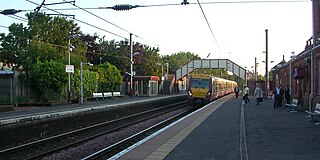
Johnstone railway station serves the town of Johnstone, Renfrewshire, Scotland. The station is managed by ScotRail and is on the Ayrshire Coast Line 10+3⁄4 miles (17.3 km) south west of Glasgow Central. Johnstone has no ticket gates but ticket checks take place occasionally.
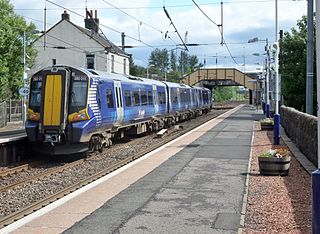
Glengarnock railway station is a railway station in the village of Glengarnock, North Ayrshire, Scotland, serving the towns of Beith and Kilbirnie. The station is managed by ScotRail and is on the Ayrshire Coast Line.

Corkerhill railway station serves the Corkerhill and Mosspark neighbourhoods of Glasgow, Scotland. The station is managed by ScotRail and lies on the Paisley Canal Line, 3¼ miles (5 km) west of Glasgow Central.
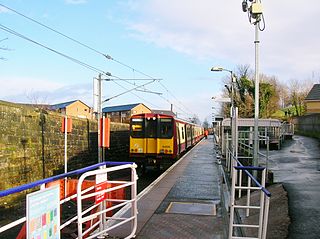
Paisley Canal railway station is a railway station in Paisley, Renfrewshire, Scotland. The station is managed by ScotRail and lies on the Paisley Canal Line.
The Bridge of Weir Railway was an independent railway company that built a line from Johnstone to Bridge of Weir. It was taken over by the Glasgow and South Western Railway (G&SWR) in 1865 and formed the base of a line that extended to Greenock, giving the G&SWR access to the harbour facilities there, competing with the rival Caledonian Railway.
The Greenock and Ayrshire Railway ran from Greenock, Scotland to Bridge of Weir, connecting there to the Glasgow and South Western Railway and making a through connection between Glasgow and Greenock. It closed progressively between 1959 and 1983.
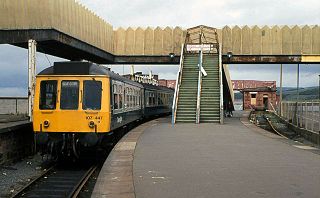
Ardrossan Winton Pier railway station served the town of Ardrossan and its harbour, North Ayrshire, Scotland. The station allowed train passengers to link with the Caledonian MacBrayne (CalMac) ferry sailings to Brodick on the Isle of Arran and other destinations.
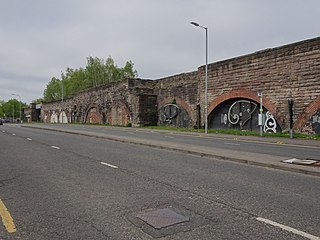
Gorbals railway station was a railway station serving the Gorbals area of Glasgow, Lanarkshire, Scotland. The station was originally part of the Glasgow, Barrhead and Kilmarnock Joint Railway.
The Greenock and Wemyss Bay Railway was a railway owned by the Caledonian Railway, providing services between Greenock and Wemyss Bay.

Kilmacolm railway station was a railway station serving the village of Kilmacolm, in the current council area of Inverclyde and the historic county of Renfrewshire in the West-Central Lowlands of Scotland. It was originally part of the Greenock and Ayrshire Railway, later a line of the Glasgow and South Western Railway.
Pollokshields railway station was a railway station in Pollokshields, a district of Glasgow, Scotland. The station was originally part of the Glasgow and Paisley Joint Railway. It was opened in 1840 and amalgamated into the neighbouring Shields Road station in 1925.
Back O'Loch Halt railway station on the Edinburgh and Glasgow Railway built Campsie Branch served part of Kirkintilloch in Scotland.

Eglinton Street railway station was a railway station approximately one mile south of Glasgow Central, in the Port Eglinton district of Glasgow.

Greenock Lynedoch was a railway station serving Greenock, Inverclyde, Scotland, originally as part of the Greenock and Ayrshire Railway.
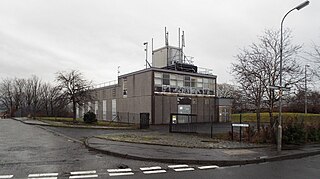
Port Glasgow Upper was a railway station serving Port Glasgow, Renfrewshire, Scotland, originally as part of the Greenock and Ayrshire Railway.
















